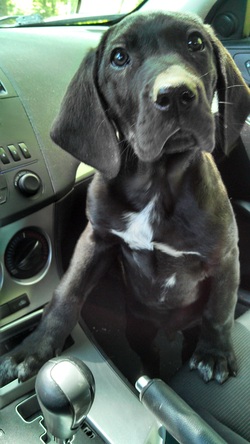|
One of the keys to puppy training is to teach your puppy that it is important to have patience and wait at feeding time. In this video, Jarvis, my twelve-week-old Labradane puppy, demonstrates how even a young puppy can have self control. It is never too early to start training your puppy about obedience and good behavior. Stay tuned for future blog posts about tips and tricks to train your puppy to stay and wait. In the meantime, you can also see another example I posted about training a puppy to stay and come. P.S. Of course the ever obedient Gatsby has a background cameo in this video. He never ceases to amaze me, and he is the most amazing role model for little Jarvis.
2 Comments
 On Saturday, May 25th I brought home an energetic new puppy to join our family. Jarvis has quickly settled into his new life with Ryan, Gatsby, Dr. Seuss, Joe, Mr. Moore, Zoey, Rory, and me, and the whole process has really made me miss all the times I got the privilege of helping my Get Pet clients with their new dogs. A couple evenings ago I tortured Ryan by reading several of my old blog posts about puppy training to him, but being the ever-supportive boyfriend, it resulted in him encouraging me to start blogging again - so here I am. Selling Get Pet was one of the hardest decisions I ever had to make, and having Jarvis around has reminded me why the decision was so hard. It brings me so much joy to watch this little guy learn and adapt, and I am always so proud of Gatsby's ability to appropriately interact with every dog he encounters. He truly is the reason that Get Pet was a success, and he immediately helped Ryan and me get Jarvis started in the right direction. Since the puppy training is so close to home this time, I thought I will focus on Jarvis' development over the next few months here on the blog, and I hope my stories and experiences can be a resource to you from one dog parent to another. Please feel free to comment and ask questions. You can always reach me via email at [email protected]. How do I teach my puppy to stop barking? It's all too common of a question, and the first thing to note is YOU'RE NOT ALONE! Dogs bark, that's a fact, and we should never forget that humans actually taught dogs to bark more than their wild cousins. How did we teach them to bark? When dogs were first domesticated, it's most likely that dogs who were better at alerting their human counterparts to threats were considered more desirable and therefore more likely to be chosen for breeding. Today, however, we teach our dogs to bark because we don't communicate correctly with them. Dogs are pragmatic; they "deal with things sensibly and realistically in a way that is based on practical rather than theoretical considerations." For this reason if a dog receives a certain response when he presents a behavior, he'll keep presenting that behavior in the future in anticipation of receiving the same response, ultimately creating a habit. For example, dog barks and you fill her food bowl, dog barks and you get her leash, dog barks and you open the door to let her back inside...etc, etc, etc. We have to shift our thinking from expecting our dogs to tell us what they want to a mindset of telling our dogs what we want. There is a widely accepted theory that one of the reasons domestic dogs bark is because they have been bred to remain in a more juvenile state. If this is true, then is your dog really mature enough to run the household or do they need some guidance from you, the adult. Ok, so enough about why dogs bark; you wanted to know how to make it stop, right? As outlined in the 7 Facts about Canine Communication there are four main categories of methods used to stop barking: 1. Collars/Devices, 2. Desensitization/Counterconditioning, 3. Psychotropic drugs, 4. Surgical debarking. I would NEVER recommend surgical debarking, and it is indeed illegal in most states. The Association of Pet Dog Trainers also takes a firm stance against surgical debarking. Ask your vet if you want to know more about psychotropic drugs like buspirone, clomipramine and amitriptylene, and don't go doing a Google search about them either. Since psychotropic drugs can have side effects, be sure to also ask your vet about homeopathic remedies like Problem Pet Solution or Rescue Remedy for Pets You can also talk to your vet about collars and devices, or you can talk to a certified dog trainer, and guess who I suggest can give you the best recommendation...YOUR VET :-)  The first thing to keep in mind is that change takes time! Don't rush your dog, and remain patient. It might also be a good idea to tell your neighbors about how you're working with your dog. I advise all my new puppy clients to slide a letter under the door of each neighbor on their floor to invite them to reach out if the puppy is barking. What's that saying? Oh yeah, "it takes a village." I am a strong believer that Step 1 to solving your dog's barking problem is to give your dog an appropriate level of exercise, obedience training and time for enrichment. Working your dog's mind is guaranteed to tire him out. Why else do you think kindergarten children require nap time when they're only in school for half a day? And you'd be amazed what an extra 30 minute walk can do for your dog's overall happiness. Step 2 to solving your dog's barking is to be consistent when you are around. If your dog barks in the crate while you're home, wait to take him out of the crate until he is quiet...even if you have to wait for an hour. If your dog stares out the window barking at dogs who walk past, tell him "No", and if he doesn't stop then close the blinds for 30 minutes. If he goes right back to barking at the window when you re-open the blinds, then close them again for 30 minutes and keep doing that until he realizes that the his barking removes his fun view of outside. Oh, and don't forget to tell him "Good boy" when he stops barking; it's even more important that you praise your dog for good behavior even if that good behavior is the act of stopping bad behavior. To summarize it all: Try to think like your dog. If someone "barked" at you to make them dinner, would you? Or would you correct them for being rude and wait for them to ask nicely? If your mom gave you a piece of candy every time you set the table without her asking, I bet you would have set the table a lot more, but if she gave you a piece of candy when you yelled "where's dinner!?!" then please don't ever let anyone in my family go on a date with For more detailed information, I recommend reading: Barking: How to Get Your Dog to Quiet Down by The Humane Society of the United States Dog & Puppy Barking Training Info by PerfectPaws.com I'm super excited to announce the newest weekly installment for my blog. I'm calling it "Tricks and Treats" because you (the humans) can win treats (aka prizes) when the pups perform tricks. For our first week 13-week-old Metro, a Danish-Swedish Farm dog, is donating the footage from his very first "sit" lesson. Here's how it works: 1. Watch the video 2. Show some love 3. Be entered in a drawing 4. Tune in next week to see if you won How do you show some love, you ask? It's easy. You can either: - post a comment here on the blog about the video - post a comment on the Get Pet Facebook page with a link back to this blog - send a Tweet to @GetPetChicago with a link to this blog - post a comment or "Like" the video directly on the Get Pet YouTube channel And you can earn up to one entry for each form of love for a possible total of 4 entries. Prizes will range from credits to use in the new Get Pet Shop to Gift certificates for awesome Chicago businesses. Enjoy Metro's video and be sure to show some love before next Wednesday, February 1st for your chance to win. I recently taught a class for www.DabbleHQ.com about what to expect and how to plan for your first dog. I thought it would be nice to share the PowerPoint and resources here on my blog for you to reference and share. If you have questions or would like more detailed information about getting your first dog, I'd be happy to talk with you one-on-one via phone, email or in person. Just visit the "Contact Us" page and send me a note. If you didn't read my first blog about Lexie, the foster who has been living with me for the past three weeks, then this video will probably just look like another cute dog video. BUT... If you read my giant rant about Lexie, then you are sure to be impressed by how much progress this amazing lady has made. This beautiful and sweet Weimaraner is definitely ready to move into her forever home. She's still full of energy since she's only one year old, but she's super intelligent and has so much love to give. Be sure to check out the Great Lakes Weimaraner Resuce page to learn more about how you can welcome Lexie (or another deserving Weim) into your family! About two weeks ago I welcomed Lexie to live with Gatsby, Dr Seuss and me until she finds her forever home. She is a very energetic sweet lady who has sadly lacked any structure during the first year of her life.
Our focus for the first week was adding structure to Lexie's life through introducing her to a schedule, leash walks and crate training which went hand-in-hand with potty training. Let me get on my soapbox for a moment and remind everyone that putting your dog out in the backyard for a couple hours unsupervised is NOT appropriate enrichment and exercise. Dogs look for a pack leader to challenge them and initiate exercise and play - that's where we are supposed to come into the picture. They WANT us to give them a "job". Okay, moving on. As you probably know by now, my approach with dogs is very direct and all about consistent exposure and reinforcement. It is my belief that dogs, like humans, learn through repetition and positive experiences but also require someone to push them outside their comfort zone to grow and mature. We need to give our dogs more credit and stop babying them as if they might "break" when confronted with a challenge. For Lexie, the introduction of boundaries and structures has translated into actual physical boundaries through crate desensitization both while I am out of the house and even while I am home doing work. Does this mean she should be in a crate 24/7 to figure out that it's okay? Most definitely NOT. It's all about balance. Currently Lexie probably is spending about 16 to 20 hours out of each day inside her crate. Yes, you read that correctly, she is spending close to 20 hours of each day in her crate, BUT for the 4 to 8 hours she is out of the crate, she is at the park on a 30-foot lead running with Gatsby, going on runs with Gatsby and me, practicing important skills like "stay" and "come" with me one-on-one, playing at the off-leash dog park, etc. Thanks to this intense attention while she is out of the crate, she is very ready for a nice long nap in her crate in between "workouts". Before you call PETA, please focus on the results. One week ago, Lexie required 3 baths per day along with 3 full deep cleanings of her crate. Why? After being in her crate for only 20 minutes, she would pee and/or poop and proceed to pace through it out of nervous energy. Her barking was also a very apparent sign of her obvious lack of familiarity to structure and independence. This display occurred even when her bladder should have been completely empty. Today, Lexie willingly walks into her crate where she is greeted by lots of enrichment (aka toys), and for the past week she and her crate have remained clean and dry. Comparing the Lexie I knew two weeks ago to the Lexie I know today, I would have to say she is MUCH happier with her new boundary-filled life. The other obvious sign of Lexie's lack of structure prior to moving in with me, is her diligent and even dangerous resource guarding habits. Please keep in mind that a dog is much more relaxed and comfortable if they have an idea of what to expect on the daily agenda - aka a structured schedule. For Lexie, the uncertainty of what time her next meal might come or whether she would get her toy back after having it taken away coupled with her inability to identify the pack leader (because none was ever introduced to her) resulted in a nervousness and aggression even when she was drinking water. Lexie would physically shake while growling when she ate or drank, and she would lash out at anyone (or any dog) who tried to approach her during that time. THE GREAT NEWS is that thanks to consistent work and positive reinforcement, Lexie has stopped the shaking, growling and snapping with toys, water and food. The breakthrough for food guarding came from an awesome tip from the super talented Cis Frankel (www.canineintelligenceagency.com). Cis is not only an amazingly talented trainer based in Chicago but also a recognized Weimaraner breeder. As fate would have it, Gatsby, Lexie and I bumped into Cis in the park, and she suggested putting only small amounts of Lexie's food into her bowl while she was eating. This turned feeding from night to day! After only one feeding where I would continually dispense a small handful into her bowl as she ate, Lexie allowed me to start grabbing her bowl and removing it while she is eating. Coming from a dog who actually bit me only a few days ago during food desensitization, this is HUGE! THANK YOU SO MUCH CIS!!!! So I realize this has probably been my longest post to date, but Lexie has also been both my biggest challenge and success, so I thought it only fair to dedicate a longer initial post to this superstar in the making! I can't emphasize enough how amazingly sweet she is Don't forget to check out the Great Lakes Weimaraner Resuce page to learn more about how you can welcome Lexie (or another deserving Weim) into your family! These videos were taken about one week after Seymour's May 20th video. Notice how much better he maintains focus and how much less I need to repeat "stay". Of course he still has the same big reaction to "ok, come". Practice makes perfect and you can NEVER stop making it a FUN GAME! As I've mentioned several times before, I believe stay and come are two commands that should be learned together. Your puppy will most likely prefer to come to you, so by teaching him to stay and using come as the release you get to reinforce both commands. Secondly, it is critical to make sure your puppy is solid with stay indoors before you practice it outdoors, and I always highly recommend using a long (30 feet +) leash when doing stay/come outdoors. This insures that if your dog breaks stay to chase something, that you still have control. Seymour is a 7-month-old mini GoldenDoodle who has been practicing stay indoors for the past several months. Everytime we come back inside he must wait on the doormat until I release him from the other side of the room. Tonight I decided it was time Seymour got to practice his amazing skills outdoors. You will notice in the video that I repeat "stay" quite frequently like a broken record, and it even gets to sound very annoying :-) As Seymour matures and is able to hold focus without being reminded, this frequency will greatly decrease. There are also a few points in the video where Seymour got distracted and either began to move forward or look off into the distance. By using either "Seymour" before saying stay or my "ah, ah" noise, I am able to re-focus him to remind him that he's working and must remain focused on the task of stay. The most fun part for me is getting to see him bound toward me at full speed with such enthusiastic excitement when I release him with "ok, come." Such a good puppy! Christmas morning started off quite rough at the Get Pet "chateau" as Rolfe and I began the day with an argument about whether or not he needed to get off the bed. This meant that a training session was mandatory before anything else could happen, but that completely connected with Rolfe and he made huge progress today! 1. He ate both of his meals in full - that's a first in the week he's been with me. 2. He stopped trying to eat Dr. Seuss and actually cuddled up with him on my bed for a nap. 3. He successfully stayed on his bed (with Gatsby at his side) for 30 minutes without trying to break and eventually fell asleep curled up next to Gatsby. 4. He finally let loose a little and played chase with Gatsby, Tugboat and Chainsaw at the dog park. He still has a lot of work to do, but I'm super proud of this affectionate little man. Enjoy the pictures and video from our crazy fun Christmas day! And REMEMBER THAT ROLFE IS AVAILABLE FOR ADOPTION! Visit http://www.great-lakes-weimaraner-rescue.com/application-requests.htm to get your application process started |
About KyleGrowing up in the country in Pennsylvania gave me tons of experience with animals from a very early age. I later pursued a career in horseback riding and also have experience as a veterinary technician. I have a strong passion for animals and have an uncanny ability to connect with all sorts of furry friends. Archives
June 2013
Categories
All
|




 RSS Feed
RSS Feed
